From inside the small control room welded to the bottom of a towering overhead crane, the operator watches the subtle hand signals of his partner, who’s standing directly underneath the swaying that’s trailer slowly dropping toward him. Watching the trailer’s descent, the groundsman gestures to his partner, and the crane operator swings the trailer over ever so slightly. It comes to rest perfectly on the narrow spine car. The groundsman confirms the trailer is in place and secures it on the flat.
Well done. But while that nice piece of choreography took place, a small truck drove beneath the crane, past the groundsman, and unhitched another, identical-looking 40-foot trailer.
And so it goes at Burlington Northern Santa Fe’s Willow Springs Intermodal Facility in Hodgkins, Ill., where every 80 seconds a trailer is lifted on or off a flatcar.
Situated in a broad valley on the west bank of the Des Plaines river, 17 miles southwest of Chicago, the yard stretches a little over two miles, yet it’s only one-third of a mile wide.
On an average day in 2001, 950 trucks dropped trailers off at Willow Springs, and an equal number of trucks departed with trailers in tow.
In 2005, Willow Springs was BNSF’s second-busiest intermodal yard, performing 770,000 lifts.
Another 40 percent of the yard’s business comes from less-than-truckloads motor carriers like Yellow Freight and Roadway – those shippers alone each contributed more than 7 percent of the facility’s total daily lifts in 2002.
The remaining 20 percent of the volume comes from truckload carriers like J.B. Hunt and Schneider National, plus the U.S. Post Office and refrigerated shipments.
Still, no matter who’s footing the bill, the mission is the same. Get the parade of incoming trailer trains unloaded as quickly as possible so they can be turned around, loaded up, and sent back out on schedule.
Managing the trains
Sounds simple enough, right? Think again.
“The trains are basically the same week in to week out,” says Alan Copeland, the senior manager of Hub Operation at Willow Springs, “but there’s always something different. There’s always something happening where we can’t build this train on this track this week, even though it was built there last week, or it was built there yesterday. Something happens and we’ve got to change the plan.”
Just how many trains are we talking about here? On average day in 2002, the terminal handled 24 intermodal trains a day – 12 in and 12 out. Toward the end of the week, as traffic builds, that number rose to 30 trains.
While most of the trains that use the facility belong to BNSF, the two eastern railroads serve the facility as well, primarily to drop off UPS their own UPS trailers. A CSX train arrives from North Bergen, N.J., five days a week; counterpart Q110 returns east. Thursdays see the once-a-week Q158 depart late morning. Norfolk Southern makes a transfer run to BNSF’s Willow Springs facility five days a week, arriving in the morning, and BNSF extended eastbound train Z-LACNYC to NS’s Ashland Avenue Yard in Chicago to expedite interchange. At other times, trailers for the Eastern roads are drayed across town.
The terminal’s busiest times are Thursday and Friday mornings between 6 a.m. and 10 a.m., when seven trailer trains file into Willow Springs for the UPS day sort. The trailers must be unloaded quickly so the rail equipment can be used on westbound trains scheduled to depart hourly from early afternoon on.
BNSF trains with a WSP symbol actually begin in Chicago at Corwith Yard, location of the engine terminal that fields the assigned power for Willow Springs trains. Approaching from the east, the locomotives will whiz right past the yard on one of two mainline tracks or an adjacent running track – often toting a cut of double-stack containers – then back into Willow Springs to pick up the loaded flatcars.
Trains are built and dumped (intermodal terminology for unloaded) on five loading tracks. An access road bisects the loading tracks in the middle of the yard, effectively creating ten separate work areas.
The loading tracks are each about 5,000 feet long. But some trains are 7,000 feet in length, requiring crews to double their trains. There is space for 290 89-foot flatcars, about 58 flatcars per yard track.
With intermodal train schedules bunched up to take advantage of peak loading and unloading times, flexibility is the key to making sure those five loading tracks can handle the volume.
“On paper, all the trains don’t fit here,” says Copeland. “They all come in at the same time, and they all go out in hour intervals. If the inbound trains are in good shape, then the outbound trains are usually in good shape. It’s just when the inbounds come in late, and we have to turn those railcars for the outbounds, then we have to be creative to get the job done.”
Much of that creativity originates in the Willow Springs operations tower, where a BNSF trainmaster will work with Copeland and managers from Pacific Rail Services – who handle the transloading and hostling of trailers in the yard, and build the outbound trains on computer – to develop a daily loading and unloading plan.
There really is no typical day at the terminal. Track assignments change daily. And even though the terminal may have three hours to build a train one day, that doesn’t mean it won’t have only two hours or less the next. The only certainty is each train’s scheduled cutoff and departure times.
Once the train information is loaded into the computer, it can be accessed by the hostler drivers and crane operators throughout the yard, who rely on that information to make sure the 3,000 look-alike trailers scattered across the 186-acre terminal’s three parking lots and five loading tracks all go where they’re supposed to go, whether it be across town or across the country.
As at each of BNSF’s intermodal facilities, much of the work at Willow Springs is outsourced to contractors. In fact, there are only a handful of railroad employees. Day-to-day operation of the yard falls to the aforementioned Pacific Rail Services. Central Intermodal runs the check-in and check-out gates, while T.R.S. handles trailer repair at a small facility near the east end of the yard.
In-Terminal Services performs repair and maintenance to the 8 overhead Mi-Jack cranes, 3 Taylor sideloaders, and 27 yard hostlers on the property. The sideloaders are needed because the fifth loading track, adjacent to the storage tracks, cannot be straddled.
At Willow Springs, 99 percent of the units handled are trailers. “The only stacking we do on a regular basis are UPS 28-foot containers,” Copeland says, “and we load those to Denver, Dallas, and North Bergen, New Jersey.”
Chicago-bound containers on BNSF are handled at one of two other area terminals. “Corwith is 85 to 90 percent containers,” says Copeland, of the downtown Chicago yard that once fielded Santa Fe’s hot Super C trailer train. “We do the trailers, they do the containers.”
The third terminal is Cicero Yard, a former hump yard on the ex-Burlington main line that was converted into an intermodal facility. It handles traffic to and from the Pacific Northwest, including UPS trailers.
However, unlike its counterparts, Willow Springs has the distinction of handling only “Z” trains – BNSF’s classification for the railway’s hottest, highest-priority trains, which are run on tight schedules and priced at a premium service level.
Trains from Willow Springs race to California terminals in Richmond, North Bay, Stockton, San Bernardino, and Los Angeles, as well as Phoenix, Denver, Dallas, and Kansas City.
In the first five months of 2001, the Willow Springs terminal performed 281,452 lifts – about 1,910 a day – or nearly 68 percent of all trailers moved on BNSF in that timeframe, and about 19 percent of the total intermodal units carried by the railway that year. Back then, the terminal’s one-day record was 2,987 lifts
Volume at Willow Springs grew in 2001 after BNSF introduced a midweek westbound trailer train for Yellow and other less-than-truckload and parcel shippers that reaches San Bernardino, Calif., in only 48 hours, four to six hours faster than its other premium trains. Train Z-WSPSBD9 leaves Willow Springs at 5:30 a.m. on Tuesday and Wednesday. Within a month of its June 5 launch, midweek LTL and parcel business grew 63 percent.
Side by side
BNSF works closely with shipper United Parcel Service to coordinate train loading. It helps that two access roads directly link the railway’s intermodal yard with UPS’s giant Chicago-area sorting facility next door. But in order for the partnership to work, cooperation has to extend beyond mere asphalt.
Computers link the two facilities as well, and help BNSF to match their equipment availability with UPS’s traffic needs. “We have an interactive electronic system,” explains Michael Johl, UPS’s Community Relations Manager at the Chicago Area Consolidation Hub.
“They know pretty much on a daily basis what we’re going to give them. One day we could have 50 loads going to a location, the next day we could have 55, but BNSF understands that we have service levels to maintain, and they maintain enough flexibility to make sure that they help us maintain those service levels.”
Copeland uses the information from UPS to finalize his plans for building trains that carry UPS traffic. “We have a cutoff time for each train. UPS lets us know when the last piece is coming in so we don’t have to save any more hitches. Occasionally if UPS is running late and they have a hot unit, they’ll call the tower or call me, and we’ll make arrangements to save a platform for that unit as long as it comes in at a reasonable time before the train’s scheduled to leave. We can always pop one more trailer up and still get the train out on time.”
Communication, cooperation, and commitment. Sounds like a winning business formula. But don’t ponder it for too long if you’re standing near the overhead cranes in Willow Springs, because there’s another trailer to lift, and another one behind it, and one more on the way.
And once they’re loaded, those trains wait for no one.
The sense of urgency and purpose felt at BNSF’s Willow Springs Intermodal Facility is similar at UPS’s sorting hub.
The impression you get when you’re inside United Parcel Service’s Chicago Area Consolidation Hub – or CACH – is that you’d best stay out of the way, because these bundles wait for no one. The air is warm from the heat given off by giant machines. There’s an underlying din, punctuated by a rhythmic ka-CHUNK, ka-CHUNK from the endless stream of packages clattering across rollers, riding swift conveyor belts, and sliding down chutes into the hands of eager trailer loaders.
It’s no coincidence these two busy operations are located right next door to each other. Half of the million-plus packages sorted each day at UPS’s CACH facility come in by rail through BNSF’s terminal.
“The original plan was for a joint Santa Fe and Conrail facility to serve UPS,” says Alan Copeland, the senior manager of Hub operations at BNSF’s Willow Springs terminal. “UPS knew we were going to build here when they started, and we knew they were going to build when we started.” Both facilities opened in 1995.
In Hodgkins, Ill., 17 miles southwest of Chicago, the railroad and customer coordinate their plans to make sure that impressive sight streaking across the Mojave Desert at 70 mph two days later all comes together.
“They’re part of the whole UPS chain,” explains Mike Johl, the Community Relations Manager at CACH, of BNSF. “They understand that every package in every trailer on every train that they move for us is guaranteed. And we work in partnership with them to make it happen.”
BNSF’s Copeland agrees. “It’s teamwork, it’s communication, it’s coordination. Keep everybody informed and everybody shares in the good fortunes we have.”
And at no time is that teamwork more necessary, or urgent, than in the late fall, when UPS shipments swell and railroads field extra trains in an effort to conquer the “fall peak.” UPS anticipated its busiest day in 2001 to be Tuesday, December 18, when it planned to deliver more than 18 million ground and air packages worldwide. In a typical fall, UPS expects to handle more than 325 million packages between Thanksgiving and Christmas.
United Parcel Service’s CACH facility is, in essence, a giant classification yard for packages. The facility was built to consolidate parcels shipped via UPS Ground from the East and West coasts, and regionally from the Midwest, and reload them into trailers for destinations throughout the United States and Canada.
On a typical day, some 1.3 to 1.4 million packages will scurry through the building. That’s 10 percent of UPS’s total domestic ground volume. In December, it gets even busier when the volume of total UPS shipments rises by 35 percent.
In 2000, the busiest day at CACH occurred two Fridays before Christmas, when UPS sent 1.87 million packages through the facility.
The building itself covers nearly 37 acres, with 1.9 million square feet of space available on two different levels. It first opened for business on March 31, 1995.
“This is the largest package distribution facility of anybody’s, anywhere in the world,” says Johl.
Third time’s a charm
On its automated journey through the building, a package will be sorted three times. But first, incoming trailers back up to one of the 126 unloading doors in the building’s midsection. A conveyor extends from each unloading door. Voicers stationed near the unloading doors check each package for a Maxicode label.
Once the voicer checks the Maxicode label, or creates one if there is no label, the package continues its ride on the conveyor. Groups of three speed-controlled conveyors merge into one sortation belt, automatically spacing the converging packages 12 inches apart, so they can be read by a Maxicode camera. This high-tech camera locates the package’s Maxicode label, decodes it, and compares the zip code on the label to a database of all possible zip codes.
Based on the camera’s reading, the package is assigned to one of 25 power diverters that are lined up along the right-hand side of the sortation belt.
Think of the diverter like a giant pinball game flipper that gently swats the package off the sortation belt and onto one of the transportation belts running perpendicular to, and beneath, the sortation belts.
A ride on the transportation belt means the package will be read a second time by a Maxicode camera, and then another diverter will push it onto a third series of sortation belts. These will whisk the package to one of ten wings where outgoing trailers are loaded. Five outbound wings extend from the east and west sides of the building. Each wing has 100 loading gates, making for a total of 1,000 outbound doors.
Entering the outbound wing on belts high above the floor, the package is read for a third time by a Maxicode camera. The camera once again reads the Maxicode label, decodes it, and again compares the zip code to a database of all possible zip codes – this time to assign the package to the correct loading door.
Within five to ten minutes of that wrist scan, a customer could log onto UPS’s web site, enter a tracking number and learn that a given package has been loaded at CACH, as well as its scheduled delivery time.
On a given day, packages in CACH are sorted to about a thousand of UPS’s 1,250 destination facilities in North America.
Daily ebbs and flows
Like a passenger train, the trailers aren’t held until they’re full. They depart at assigned pull times scheduled to meet train cutoff times and UPS’s own guaranteed delivery times. As with the inbounds, the outbound truck-rail split is about 50/50.
UPS bases 550 drivers out of its Hodgkins facility. Two separate maintenance bays keep those unique brown cabs in working order. The entire CACH facility employs just under 11,000 people.
There’s a different process for small packages-anything under 10 pounds or about the size of a shoebox. They’re segregated to reduce damages that might result from sending a smaller package through the automated system.
“If a small, very light package were to get between two large 150-pound boxes of nuts and bolts, say, it’s not going to survive,” Johl notes, wryly.
Small packages are diverted to their own sorting facility on the second floor. There, ten sortation machines, affectionately known as Bullfrogs, send packages on conveyors and down chutes into a net bag that collects all the packages for a given destination. Once full, the bag is sealed and replaced. The loaded bag gets its own Maxicode label and is sent through the system. Inside the bag, packages ride intact to their outbound destination trailer.
Between 25 and 28 percent of the daily packages sorted at CACH are smalls. Regular packages comprise 70 percent of the volume.
The rest are large, unwieldly packages that are sorted in yet another separate process, because the machines could never handle them. UPS calls these irregulars – items such as wooden crates, tires, bare steel, five-gallon pales…you get the picture.
Each shift – UPS calls them sorts – last between three and five and-a-half hours, which is the window of time UPS needs to get inbound trailers to the facility, unload them, sort the packages, and send the trailers back out to their destinations.
The sunrise sort begins at 3 a.m., followed by the day sort at 10 a.m., the twilight sort at 5 p.m., and the night sort at 10:30 p.m. That means packages are moving through the facility in very concentrated, narrow windows of time.
But not to worry. The average time it takes a package to scurry through the building is less than fifteen minutes. “From the time it gets picked up to be unloaded to the time it gets picked up to be loaded into an outbound trailer, it’s less than fifteen minutes,” Johl says with obvious pride.
Packages bound for UPS distribution facilities less than 400 miles away are trucked. Greater than 400 miles, there’s a train ride in that trailer’s future.
And that’s where BNSF comes in.





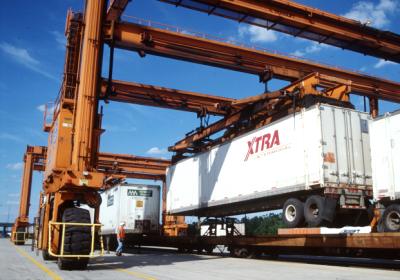
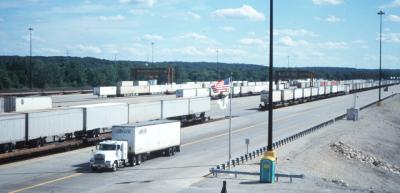
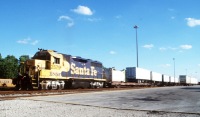
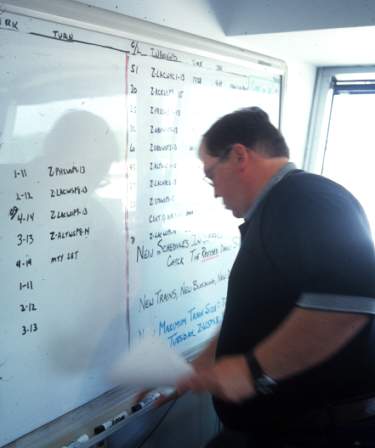
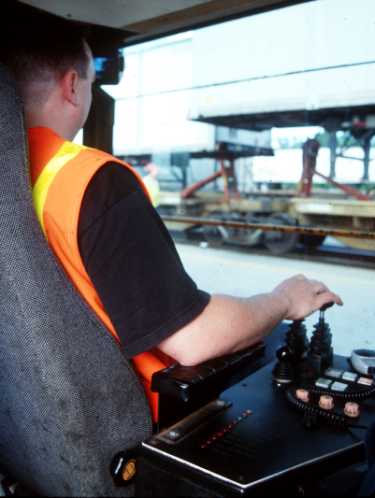
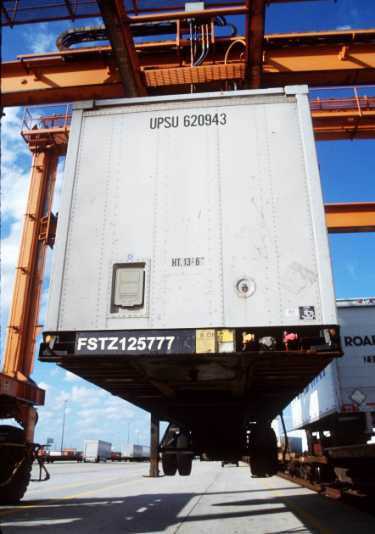
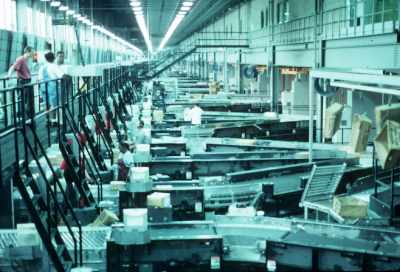
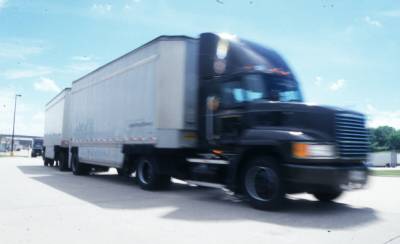
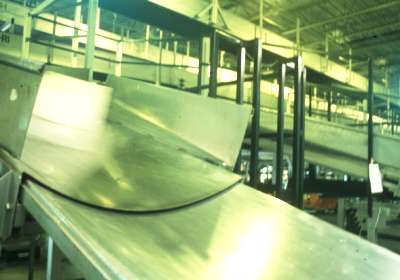
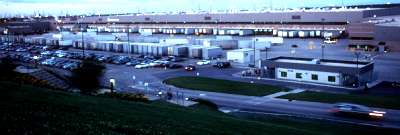









Matt, I’m late to the party but felt bound to share my thoughts. This is masterful nonfiction trade writing, most enjoyable to read.